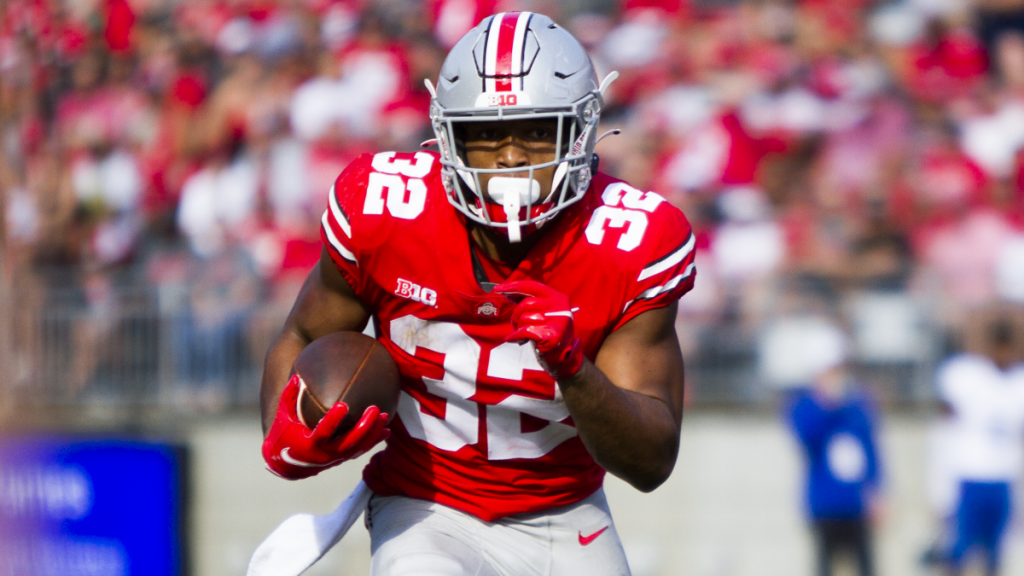As we get into Devy draft season, below are my top five Devy RBs you should be looking to acquire. I’ll walk you through my process, comparing & contrasting the players on the analytical metrics of size & production. This process is about increasing the odds of a player’s success in the NFL. Let’s get to it!
The Top Five
1. Bijan Robinson, Texas, Class of 2023
This is more like 1a and 1b with Robinson and #2 Henderson. If I were to break the top five into tiers, there would be a break after #2. Robinson is a 247Sports composite 5-star out of Tucson, Arizona. Click this LINK for a Dynasty Nerds devy spotlight profile of Robinson. As a true freshman, he dominated the Texas backfield and had similar results his sophomore year. In the devy community, Robinson is touted as the best RB prospect since Saquon Barkley.
After his freshman year, he has consistently been the #1 devy RB and usually the first non-QB off the board in most drafts. In Robinson’s sophomore year, he got a new coach, Steve Sarkisian. And this year, they added a couple of transfers to the offense in highly touted QB Quinn Ewers and WR Agiye Hall. Those transfers with Robinson and Top 5 devy WR Xavier Worthy make for a dangerous Texas offense. Given all the firepower, defenses will not be able to key in on stopping Robinson. This may open him up to an even better year in 2022.
2. TreVeyon Henderson, Ohio State, Class of 2024
Henderson is a 247Sports composite 5-star out of Hopewell, Virginia. He arrived on campus and almost immediately took over the OSU backfield. Then he put up one of the most prolific true freshman RB seasons OSU has seen since JK Dobbins in 2017 or Maurice Clarett in 2002. The setup for the 2022 season is good as well, with Heisman Trophy candidate CJ Stroud and a well-motivated Buckeye squad set to dominate the Big Ten after a tough loss last season to rival Michigan. Henderson is an NFL class of 2024 guy, so if you draft him in devy, you will have to wait two full seasons before he gets to your NFL squad. Henderson is dominant with the ball in his hands and deserves to be at the top of any devy RB rankings.
3. Jahmyr Gibbs, Alabama, Class of 2023
Gibbs is a 247Sports composite 4-star out of Dalton, Georgia. Gibbs played his first two seasons at Georgia Tech and then this year transferred to Alabama, where expectations have skyrocketed. Being on the smaller side, Gibbs has made a name for himself as a pass-catching back. Already viewed as one of the best devy RBs, transferring to Alabama, with its rich history of producing NFL RB talent, Gibbs has a good shot at locking himself into the first or second round of the NFL draft in 2023. More on this below, but the concern on Gibbs is size/weight. Hopefully, after Alabama’s strength and conditioning gets a hold of him, he can bulk up a bit. This way, evaluators will see him more as an every-down back.
4. Zachary Evans, Ole Miss, Class of 2023
Evans is a 247Sports composite 5-star out of Houston, Texas. Evans played his first two seasons at TCU. He was largely thought of as one of the best RBs of his class coming out of high school. And he certainly showed flashes of that at TCU. For 2022, Evans decided to transfer to Ole Miss and join up with Lane Kiffin and a star-studded group of transfers, headlined by Evans and Jaxson Dart (formerly of USC). Evans is a bit of a projection, given his production numbers are not elite (yet). But all signs point to a dominant Evans in 2023.
5. Sean Tucker, Syracuse, Class of 2023
Tucker is a 247Sports composite 3-star out of Towson, Maryland. He went from a little-known devy RB and blew up after very productive freshman and sophomore campaigns at Syracuse. Click this LINK for a Dynasty Nerds devy spotlight profile on him. Honestly, Tucker at #5 was my most challenging decision in the entire top five because there are 3-4 others that could have easily been #5. He sneaks in based on his outstanding production profile. Also, this has nothing to do with his ranking, but Tucker is a great follow on Twitter!
Before I say goodbye to 2021 here's the Official list of my accomplishments. I'm in the off-season now working on my off-season goals. I'm looking forward to the 2022 season, let's go Orange! pic.twitter.com/EU5oSrUsqa
— Sean Tucker (@seantucker2020) January 1, 2022
Size Comparison
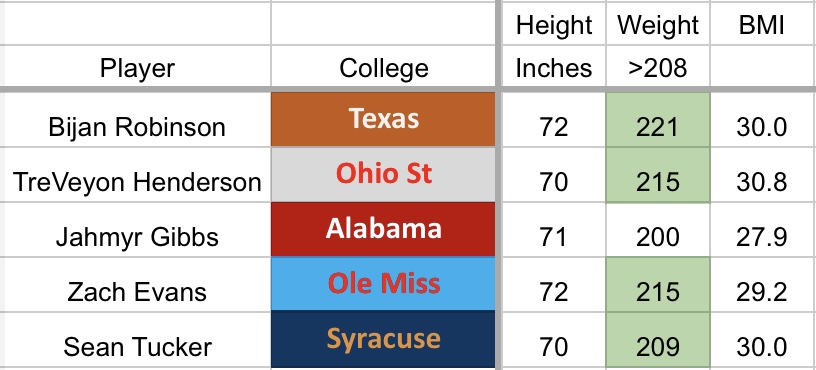
Above is their data on height & weight. I used that data to calculate each player’s BMI. Unfortunately, until the NFL combine, we are at the whim of the individual school rosters for their height and weight measurements, which can be accurate but are often not.
For RBs, size matters a lot. They have to be big enough to earn a workload and sustain it without getting injured. The primary size threshold I use is weight >208lbs. I think it’s important that if you use an RB BMI threshold, it should be combined with a weight threshold. If I could only pick one size threshold for RBs, I’d pick weight over BMI. The point is, if you establish a BMI threshold of >29, an RB that weighs 190lbs can have a BMI >29, but it’s unlikely that an RB at 190lbs is a team’s workhorse RB.
Combining weight >208lbs and BMI helps ensure you are getting big & thick guys that could potentially be a #1 RB. So to sum it up, BMI thresholds help with hit rates but aren’t statistically significant by themselves. BMI does help from an injury perspective, i.e., those RBs with BMIs less than 28 may be more likely to get injured.
As you can see from the weight/BMI chart above, four of the five RBs hit the weight threshold we are looking for. The only one that doesn’t meet the threshold is Gibbs. As I mentioned above, this is Gibbs’s first year at Alabama and his first summer in the Alabama strengthening and conditioning program. The key for Gibbs would be to put on 8lbs. And remain as fast and explosive as he has shown to be in his first two seasons at Georgia Tech. If he cannot bulk up, I would consider moving him outside the top five devy RBs because it would then become unlikely that he can become a three-down workhorse RB in the NFL.
Production
One way to measure college production related to success in the NFL is via market share. Essentially how much of a team’s offense goes through a particular player. For RBs, we will look at yards per team play (YPTP), dominator rating, and receptions % market share. And to further clarify, an RBs dominator rating is his share of team rushing and receiving production (50% yds / 50% TDs).
Now let’s look at some charts to see how these top 5 RBs compare production-wise.
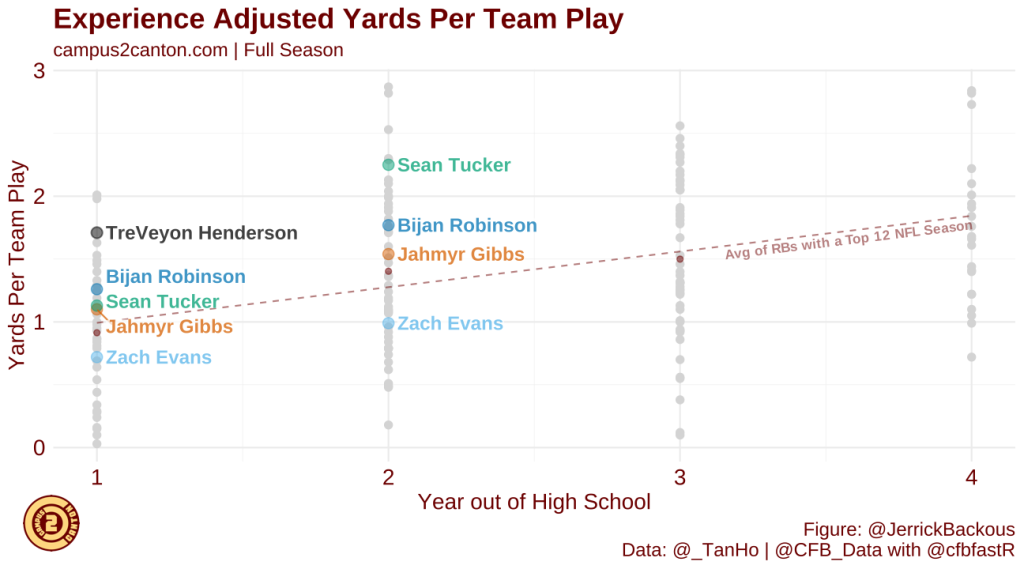
This chart is the top five devy RBs YPTP at each player’s years of experience out of high school. The upward-sloping dashed line (in all these charts) is historically what the average YPTP was for RBs with Top 12 fantasy NFL seasons (i.e., NFL success). So when looking at this chart, you want to see players that remain above the line throughout their careers.
As you can see, everyone is above the line for every year they have played except Evans. Henderson has only played one year, but he had an amazing year from a YPTP perspective. And Tucker had an outstanding Year 2. Robinson and Gibbs are consistently above the line. As discussed above, Evans being in the Top 5 reflects his flashes/tape and less on his market share production. In contrast to WRs, where you want to see them hit market share thresholds in years one and two, in my opinion, it’s not as crucial for RBs to hit those thresholds as early, just that you hit thresholds before you graduate. So the big assumption here is that Evans is dominant this season in the new Ole Miss offense with Lane Kiffin at the helm because the talent is undoubtedly there.
Dominator Rating
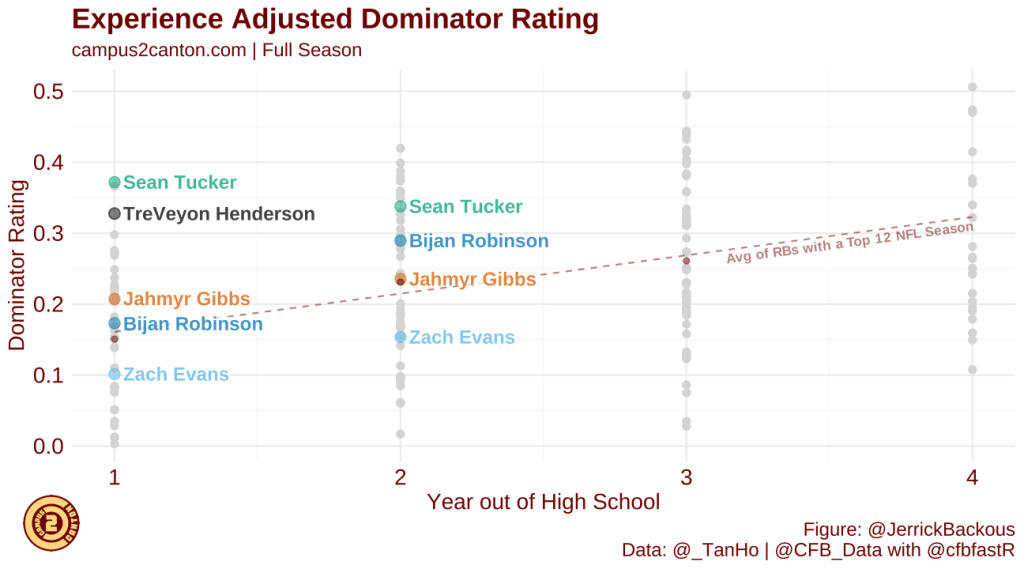
This chart is the top five devy RBs Dominator Rating (50/50) at each player’s years of experience out of high school. Again you want to stay above the line. Tucker looks even better from this perspective. This largely can be explained by Tucker being the majority of a not-great Syracuse offense in the 2020 COVID season. Again, everyone is above the line in all years except Evans. There’s no reason to rehash Evans as it’s largely the same explanation as YPTP.
Reception Market Share
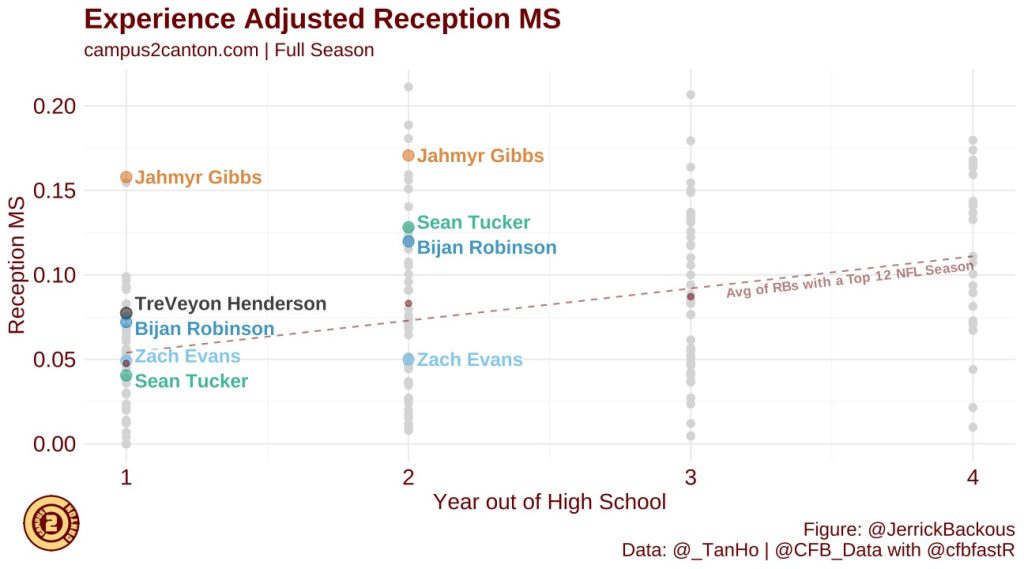
And finally, this is the top five devy RBs on a reception % market share basis. This is included because to be a truly dominant fantasy RB in the NFL, given the current environment, you have to not only pound the rock but also be at least sufficient (most likely excellent) at catching passes out of the backfield. As you can see, Gibbs excels at this with >15% market share of team receptions in his first two seasons. This is why Gibbs gets ranked #3 in the top five. Watch out if he can keep this up and get to the size thresholds. It’s a theme for him from a production perspective, but Evans is someone we are projecting great production from this year, so hopefully, he can get above the line here in his third year.
Zach Evans
I keep making production exceptions for Zach Evans and alluding to everything coming together for him this year. That largely stems from the flashes of elite potential he was able to put on tape. Here is a comment from one of my favorite devy analysts, @daboys_22 of the Footballguys and The Devy Royale.
I’m making exceptions because of runs like this, elite talent, and I’m hoping he puts it all together this year at Ole Miss.
Advanced Stats
One advanced stat that analysts like to evaluate RBs is Rush Yards Over Expectation (RYOE). RYOE is rush yards over expected, where the expected rush yards model is based on the level of competition and game situation.
Here is a Twitter post from Jerrick Backous from Campus2Canton.com talking about what career RYOE is and applying it to the 2022 draft-eligible RBs.
A look at the Career RYOE for RBs expected to be drafted this year based on @GrindingMocks data.
— Jerrick Backous (@JerrickBackous) February 18, 2022
Rushing Yards Over Expected is a model I created based on down, distance, distance to goal, opponent ypc allowed, win probability, etc. pic.twitter.com/7csuAFZPNU
Backous makes the point that “Not all carries are created equal. The goal is to determine who over/underperformed on their carries given the player’s situation.” The expected model is based on “down, distance, distance to goal, opponent yards per carry, win probability, etc.”
Here are the top five devy RBs by Career Rush Yards Over Expectation (RYOE).
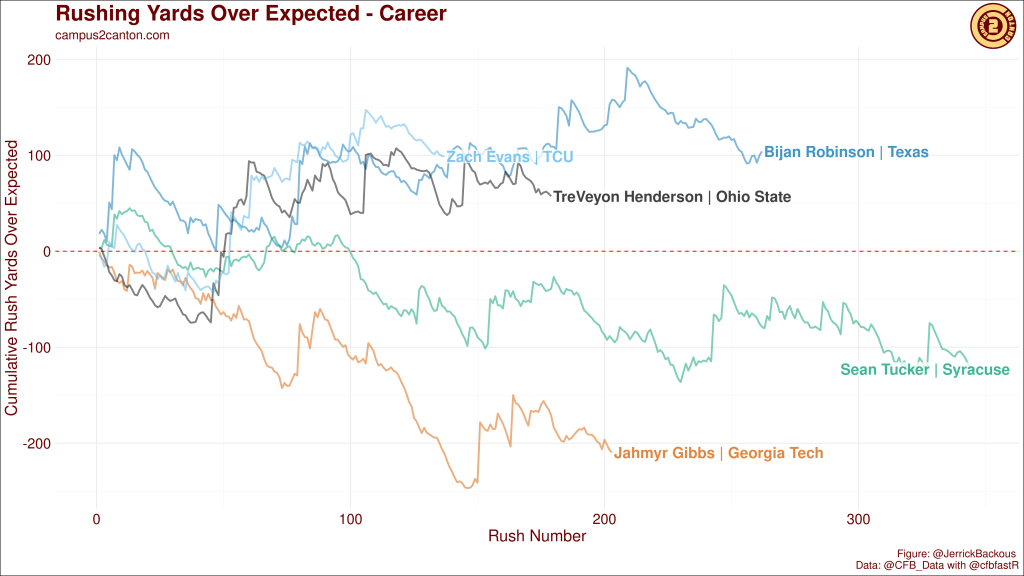
So what we are looking for here is to be above zero on career RYOE. As you can see, Robinson, Henderson, and Evans are over zero. Gibbs and Tucker are below zero. Some of the underperformance may have to do with the competition both Gibbs and Tucker faced playing in the ACC. However, Gibbs transferring to Alabama (SEC) will raise his level of competition, and you may see a marked increase in his RYOE from here. It has been argued that RYOE is not significantly correlated to NFL success, but it is fascinating, nonetheless.
Putting it All Together
From a size perspective, four of the five RBs check the box. Gibbs is the one that we are hoping can add at least eight pounds without losing how fast and dynamic he is.
From a production perspective, Robinson and TreVeyon check all the boxes on YPTP, dominator rating, reception market share, & career RYOE. Robinson’s done it for two straight years, and Henderson for one, but both check all the boxes from a size and production perspective, which is why they are 1a and 1b.
Gibbs looks pretty good from a production perspective, except for career RYOE, which may substantially increase playing at Alabama next year. He is exceptional at receptions market share, and hopefully, that continues playing with the Tide. Gibbs is my #3 ranked RB, with size and production not being perfect.
Evans fits the model from a size perspective but hardly hits any of the production metrics we are looking at. This is more of a projection for an outstanding season at Ole Miss, but he comes in at #4. And finally, Tucker, an overlooked 3-star RB that smashes most production metrics (except RYOE) but maybe doesn’t show elite traits on film. I think I have to include him in the top five from what he’s been able to show from a production standpoint, but I can easily see less productive but elite talent guys ranked above him for devy purposes.
Just Outside the Top 5 Devy RBs in Alphabetical Order
Braelon Allen, Wisconsin
Tank Bigsby, Auburn
Donovan Edwards, Michigan
Kendall Milton, Georgia
Will Shipley, Clemson
Nicholas Singleton, Penn State
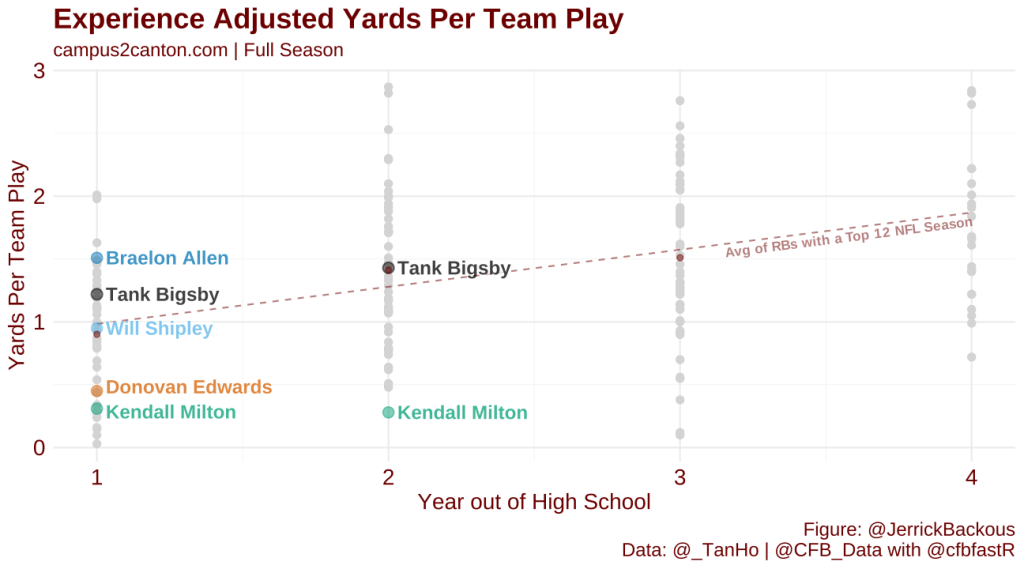
Conclusion
These are my top five Devy RBs going into the 2022 season: Robinson, Henderson, Gibbs, Evans, and Tucker. I think it would be a good idea to target these RBs in Devy leagues because I think they all have a decent probability of success in the NFL. Your top five may be different, but examining size and production gives you a clearer idea of what to look for in a devy RB.
If you are interested in learning more about Dynasty/Devy fantasy football, please follow along on Twitter @_jasonstein and let me know what questions you have and how I can help.
Make sure you subscribe to the #NerdHerd, where you get exclusive content, dynasty/rookie/devy rankings, buy/sell tool, and a bonus podcast. Dynasty Nerds also recently launched the #DynastyGM tool, a complete game-changer in the fantasy industry. Click here for a free trial. We truly are your one-stop shop for all your fantasy football needs!

